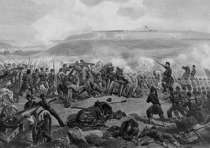
The engagement at Fort Donelson (February 13-16, 1862) pitted the faulty command by Southern officers against Union numerical superiority, Grant's flexibility, and a crucial shift in fortunes from one combatant to the other.
Tennessee Confederates constructed the earthen fort in the summer of 1861 to defend the river approach to Middle Tennessee and Nashville. In early February Confederate department commander Albert Sidney Johnston concentrated some 15,000 men to defend against Union General U. S. Grant's army of 17,000 to 21,000 men and Flag Officer Andrew Hull Foote's six-vessel gunboat flotilla.
Within a week of Fort Henry's capture on the Tennessee River by Grant on February 6, 1862, nearby Fort Donelson on the Cumberland River came under siege by the same Union force. The engagement at Fort Donelson (February 13-16, 1862) pitted the faulty command by Southern officers against Union numerical superiority, Grant's flexibility in crisis, and a crucial shift in fortunes from one combatant to the other. Johnston had dispatched four generals with vague instructions to defend the post, with eventual evacuation to save the force from capture. Meeting in council of war at a hotel in the nearby Stewart County seat of Dover, Floyd, Pillow, Buckner, and Forrest assessed their situation. Still unable to agree on a course of action, eventually Forrest, Floyd, and Pillow resolved to flee independently, while Buckner agreed to remain and surrender.
On the morning of February 16, Grant and Buckner met to discuss surrender. Grant telegraphed his superiors to report the capture of 12,000-15,000 prisoners and a large cache of supplies and arms. Within weeks of the fall of the river forts, Tennessee's capital fell to Union troops, and the state government fled into exile. The deep wedge driven into Tennessee so early in the conflict subsequently introduced Union political and military reconstruction, as well as popular resistance. With the loss of a Confederate field force of corps strength, the Union reclaimed much of Middle Tennessee as well as Kentucky. Despite several attempts in 1862 and 1863 to recapture the Cumberland position, the Confederacy never redeemed the losses. Above all, Fort Donelson vaulted an unknown Union general into prominence. The road to the presidency of the United States began for Ulysses S. Grant at Fort Donelson.
Tools
Key Facts
- Within weeks of the fall of the forts, Tennessee's capital fell to the Union.
- The Union reclaimed much of Middle Tennessee and Kentucky, and the Confederates never redeemed the losses.




